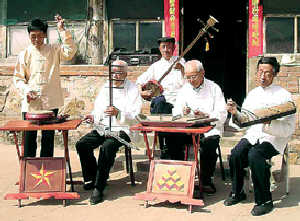That splendid period has been gone for more than one hundred years.
 Wuyin Dagu
Wuyin Dagu
 Location: Wumudi of Miyun County
Location: Wumudi of Miyun County
Artists: Qi Dianzhang (79 years old), Qi Dianming (71),
Li Maosheng (60), Chen Zhenquan (63), Jia Yunming (64)
Wuyin dagu, also called " Miyun's Naxi guyue"(Miyun's Naxi Ancient Music),
was created at Wumudi in rural Beijing's Miyun County, where this endangered
folk art is transmitted from generation to generation.
According to experts, Wuyin dagu originated in the countryside of present Hebei
Province of North China in the time of the Qing Emperor Daoguang's reign
(1821-1851). Wuyin dagu is a part of the dagu family, a division of shuochang or
singing-storytelling performance in which the singer accompanies himself or
herself with a drum and ban (a percussion instrument made of two wooden boards).
The most famous of the other schools of dagu include
Jingyun dagu and Xihe dagu, where the performer sings and talks in local Beijing
dialect.
Related:Finding the Root of Beijing Dagu Shu(II)
